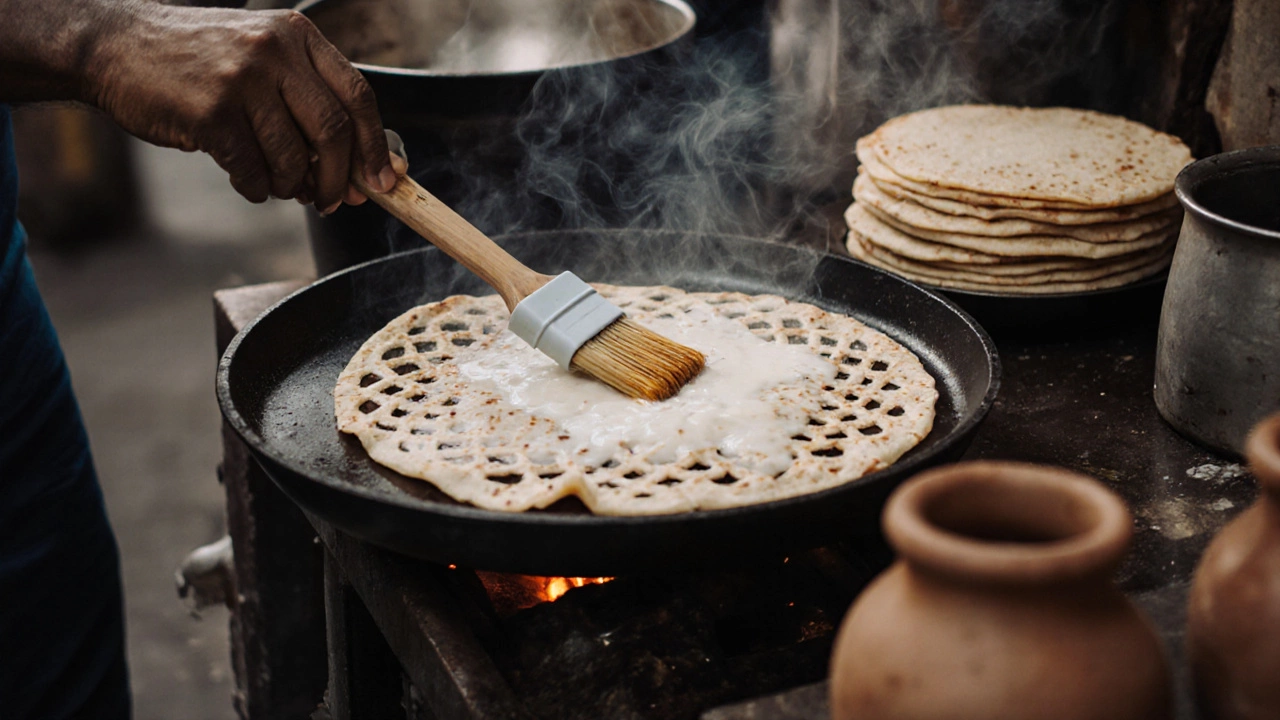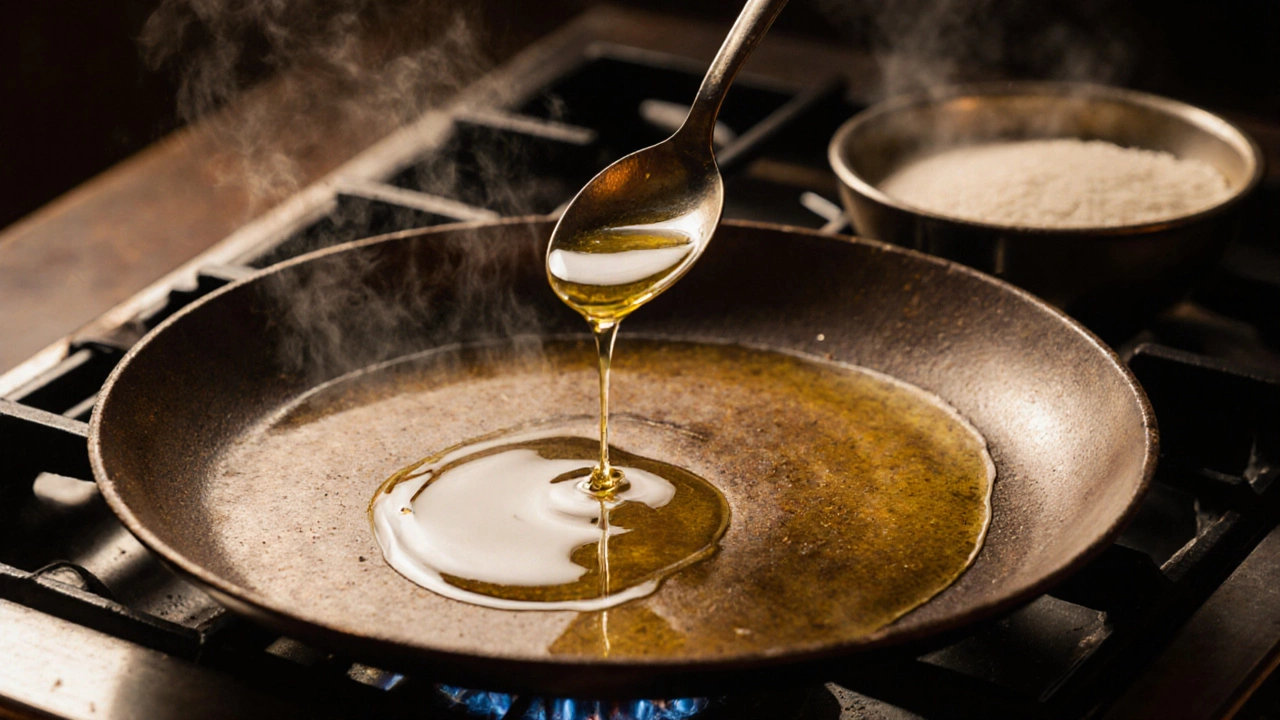31 Oct 2025
- 0 Comments
Dosa Oil Selector
Let's Find Your Perfect Oil
Answer a few questions to get personalized recommendations for your dosa
Recommended Oils
Select your priorities to see personalized recommendations
Getting the perfect dosa isn’t just about the batter-it’s about the oil. Too little, and it sticks. Too much, and it’s greasy. Wrong oil, and you lose that signature crispness and subtle aroma that makes a dosa unforgettable. The oil you choose changes everything: texture, flavor, even how well the batter spreads. So which oil is best for dosa? It’s not a one-size-fits-all answer, but there’s a clear winner for most home cooks-and a few smart alternatives if you’re tweaking for health or taste.
Why Oil Matters More Than You Think
A dosa isn’t just a pancake. It’s a thin, fermented crepe that needs to crisp up fast on a hot griddle without burning. The oil acts as a heat conductor, a non-stick barrier, and a flavor carrier. If the oil smokes too early, your dosa turns bitter. If it’s too light, the batter sticks and tears. And if it lacks flavor, your dosa tastes flat-even if the batter is perfect.
Traditional South Indian kitchens use one oil above all others: coconut oil. Why? Because it has a low smoke point but high saturated fat content, which means it heats evenly and crisps the edges without soaking in. It also gives dosa that unmistakable nutty, slightly sweet aroma that you can’t replicate with neutral oils.
Coconut Oil: The Classic Choice
Refined coconut oil is the go-to for most households in Kerala, Tamil Nadu, and Karnataka. It’s odorless and flavorless compared to virgin coconut oil, which makes it ideal for dosa where you want the fermentation and rice flavor to shine-not overpower it. Refined coconut oil has a smoke point around 204°C (400°F), which is perfect for medium-high heat cooking on a tawa.
Here’s what happens when you use it:
- Creates a thin, even film on the griddle-no pooling
- Leaves a light golden crust without burning
- Helps the batter spread smoothly without sticking
- Adds a subtle richness that lingers on the palate
Many chefs who’ve cooked dosa for decades swear by it. In Chennai, street vendors use refined coconut oil because it’s consistent, affordable, and gives that authentic taste. If you’ve ever had a dosa at a small roadside stall in Madurai and thought, ‘This tastes different from home,’ chances are it’s the oil.
What About Sesame Oil?
Sesame oil is a popular alternative, especially in Andhra Pradesh and Telangana. But here’s the catch: you want light sesame oil, not the dark, toasted kind. Toasted sesame oil has a strong, nutty flavor that can overwhelm the delicate sourness of fermented batter. Light sesame oil, on the other hand, has a higher smoke point (210°C / 410°F) and a clean taste.
It’s a great option if you want a slightly nuttier dosa without coconut’s sweetness. It also has more monounsaturated fats, making it a bit healthier than coconut oil. But it’s pricier and harder to find in some regions. If you use it, apply it sparingly-just a light brush. Too much, and the dosa turns bitter.
Can You Use Olive Oil?
Some health-focused cooks try olive oil, especially extra virgin. Don’t. Extra virgin olive oil has a smoke point of just 160-190°C (320-375°F), which is too low for dosa. It smokes quickly, turns bitter, and leaves a greasy film. Even light olive oil (smoke point ~210°C) isn’t ideal because it lacks the saturated fat structure that helps create crisp edges. You’ll get a softer, soggier dosa.
There’s one exception: if you’re making a sweet dosa with jaggery and coconut, a tiny drizzle of good olive oil on the side might work. But for savory dosa? Skip it.

Vegetable and Canola Oil: The Neutral Option
If you can’t find coconut oil or don’t like the taste, refined vegetable oil or canola oil are your backup choices. They’re neutral in flavor, have high smoke points (230°C+), and are widely available. They won’t add any flavor, but they’ll get the job done.
Here’s the trade-off: dosas made with vegetable oil tend to be crispier on the outside but less flavorful. They also don’t hold up as well when folded or stuffed. You might notice they cool down faster and lose their crunch quicker than those made with coconut oil.
Pro tip: If you use vegetable oil, heat the tawa a bit hotter than usual. The lack of natural fat means you need more heat to crisp the edges properly.
What About Ghee?
Ghee is a favorite for masala dosa, especially when drizzled on top after cooking. But using it to cook the dosa itself? That’s risky. Ghee has a smoke point of around 190-200°C, which is borderline for dosa. It browns quickly and can burn if your tawa is too hot. Plus, it’s expensive and adds a strong buttery flavor that masks the batter’s natural tang.
Best use for ghee: brush it lightly on the finished dosa before adding potato filling. It melts beautifully and adds richness without interfering with the cooking process.
How Much Oil Should You Use?
Less is more. You don’t need to pour oil on the tawa. A teaspoon per dosa, spread with a paper towel or silicone brush, is enough. Too much oil makes the dosa greasy and heavy. Too little, and it sticks.
Here’s a simple rule: if you can see oil pooling around the edges of the dosa, you’ve used too much. The oil should vanish into the batter as it cooks, leaving behind a thin, even sheen-not a slick.

Temperature Matters Too
No oil works well if your tawa isn’t hot enough. Preheat the griddle on medium-high for at least 5 minutes. Test it by sprinkling a few drops of water-if they sizzle and dance, you’re good. If they just sit there, wait longer.
Once the tawa is hot, wipe it with a damp cloth to remove dust, then apply oil. Don’t oil the tawa before it’s hot-it won’t spread evenly.
Final Recommendation
If you want authentic, crispy, flavorful dosa every time, use refined coconut oil. It’s the gold standard for a reason. It’s affordable, widely available in Indian grocery stores, and delivers the texture and aroma that define a great dosa.
Use light sesame oil if you want a nuttier twist and don’t mind the cost. Stick with vegetable or canola oil only if coconut oil isn’t an option. Avoid olive oil and ghee for cooking-save them for finishing.
And remember: oil isn’t the only factor. Your batter needs to be properly fermented (at least 8-12 hours), ground fine, and slightly runny. But even the best batter fails without the right oil.
Quick Reference: Best Oils for Dosa
| Oil Type | Smoke Point | Flavor Impact | Crispiness | Best For |
|---|---|---|---|---|
| Refined Coconut Oil | 204°C (400°F) | Mild, slightly sweet | Excellent | Authentic taste, everyday use |
| Light Sesame Oil | 210°C (410°F) | Nutty, subtle | Very Good | Nutty twist, regional styles |
| Vegetable/Canola Oil | 230°C+ (450°F+) | Neutral | Good | Neutral flavor, availability |
| Extra Virgin Olive Oil | 160-190°C (320-375°F) | Strong, fruity | Poor | Avoid |
| Ghee | 190-200°C (375-390°F) | Buttery, rich | Good (if used sparingly) | Finishing drizzle only |
Frequently Asked Questions
Can I use butter instead of oil for dosa?
No. Butter burns easily at dosa-cooking temperatures and will turn bitter. It also contains water, which prevents crispness. Stick to oils with higher smoke points.
Is coconut oil healthy for dosa?
Refined coconut oil is high in saturated fat, but it’s stable at high heat and doesn’t oxidize like polyunsaturated oils. In moderation, it’s a better choice than vegetable oils that break down under heat. Traditional diets in South India use it daily without issues.
Why does my dosa stick even with oil?
Usually, it’s because the tawa isn’t hot enough, or the batter is too thick. Make sure your griddle is properly preheated and your batter is pourable-like thick cream. Also, use only a light film of oil. Too much oil can create a barrier that prevents the batter from bonding to the surface properly.
Can I reuse oil after making dosa?
Yes, if you strain it through a fine mesh to remove batter bits. Refined coconut oil and vegetable oil can be reused 2-3 times. But don’t reuse oil that smells off or looks dark. It’s not worth the risk of bitterness or rancidity.
What’s the difference between virgin and refined coconut oil for dosa?
Virgin coconut oil has a strong coconut smell and flavor, which can overpower the subtle sourness of fermented batter. Refined coconut oil is processed to remove odor and taste, making it neutral and ideal for dosa. Unless you want a tropical twist, go with refined.
